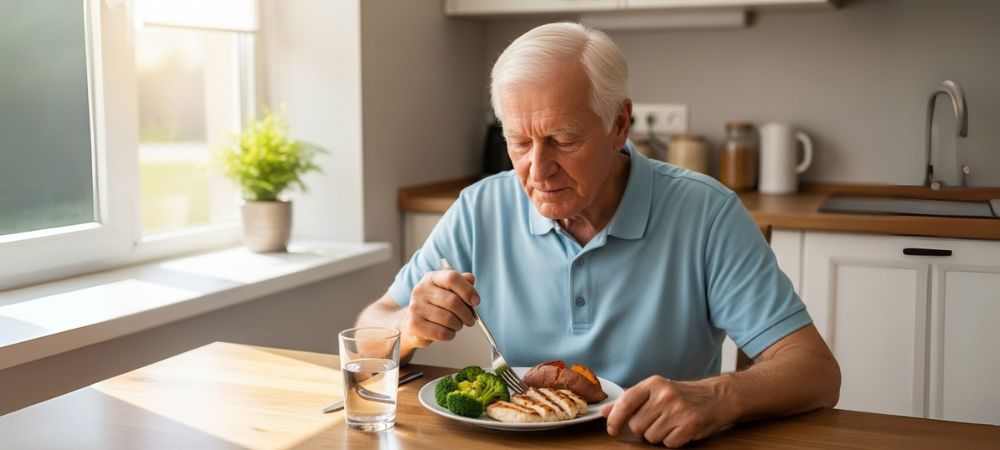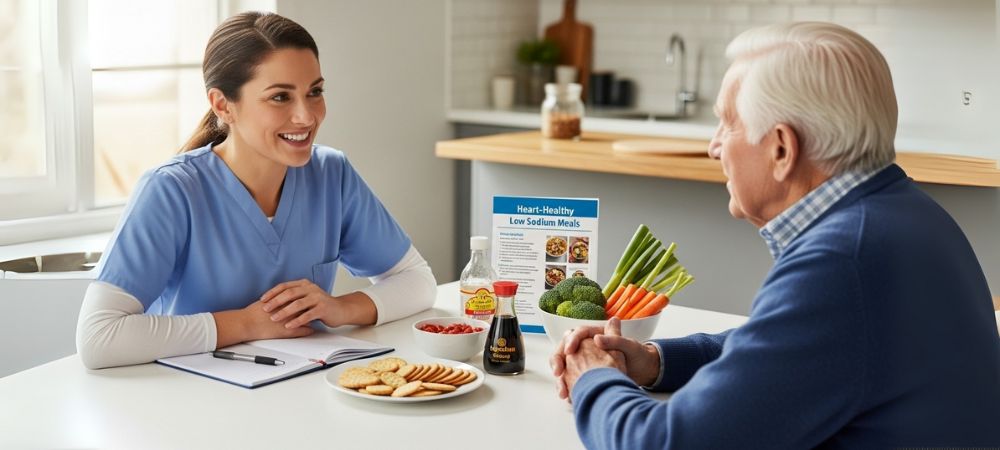Medically Reviewed by Jane Smith, Registered Dietitian Nutritionist, written by the Loving Homecare Care Team.
Looking for low-sodium meals for seniors that are both delicious and easy to prepare? As we age, keeping our hearts healthy and managing blood pressure becomes even more important. The best part is that reducing salt in your diet does not mean your food has to be bland or complicated. With the right low sodium recipes for seniors, you can enjoy meals that are flavorful, nourishing, and simple to make at home.
According to the American Heart Association (AHA), most adults, especially seniors, are recommended to consume no more than 1,500 milligrams (mg) of sodium per day to support heart health and manage blood pressure
In this guide, you will find 11 simple and easy low sodium meals for seniors that prove healthy eating can still be tasty and satisfying.
What is a Low-Sodium Diet?

What is a Low-Sodium Diet?A low-sodium diet, also sometimes known as no salt added diet, is a meal that purposefully limits a person’s sodium intake. Such diets are often recommended by doctors to help individuals deal with various health conditions, including high blood pressure, heart disease, or kidney-related issues. This diet may also be recommended to improve a person’s nutrition and overall well-being.
According to the Centers for Disease Control and Prevention (CDC), a key goal of a low-sodium diet is to limit sodium intake to less than 2,300 mg per day.
Whether a low-sodium diet is recommended by a doctor or you are on it as a precaution, it ensures that you enjoy a happy and healthy life for as long as possible.
Why Should You Choose Low-Sodium Meals?
Choosing low-sodium meals is especially important for seniors. Here are the key benefits:
- Helps in Managing Blood Pressure: Lower sodium intake reduces strain on the arteries, making it easier to keep blood pressure under control.
- Supports Heart Health: Too much sodium can increase the risk of heart disease. Low-sodium meals protect the heart and promote better circulation.
- Improves Kidney Function: The kidneys work hard to filter excess salt. A low-sodium diet reduces the burden, helping them function more effectively.
- Reduces Fluid Retention: Sodium can cause the body to hold onto extra water, which may lead to swelling and stress on the heart. Eating low-sodium meals helps prevent this.
- Encourages Healthy Aging: Nutritious, low-sodium foods support energy, digestion, and overall wellness, making daily life more comfortable.
- Promotes Independent Living: By keeping blood pressure, heart, and kidneys healthy, seniors can maintain their independence and enjoy a better quality of life.
11 Simple & Easy Low-Sodium Meals for Seniors
Key Takeaways
- Seniors can enjoy low sodium meals that are both healthy and flavorful.
- Simple swaps, like using low-sodium soy sauce or unsweetened almond milk, help reduce salt without sacrificing taste.
- Meals should focus on being nutritious, easy to prepare, and senior-friendly.
Meal 1: Peanut Butter Banana Overnight Oats
Key Ingredients:
- Rolled oats
- Unsweetened almond milk (or other milk alternatives)
- Banana slices
- Low-sodium peanut butter
Why It’s Great for Seniors:
This no-cook breakfast is easy to prepare, gentle on digestion, and provides steady energy until lunch. It’s one of the best easy low sodium meals for elderly who prefer something simple but filling.
Preparation Tips:
- Add chia seeds or ground flaxseeds for extra fiber.
- Use unsweetened almond milk to keep calories low.
- Drizzle with a little honey or maple syrup for natural sweetness.
Meal 2: Low-Sodium Vegetable Stir-Fry
Key Ingredients:
- Broccoli, bell peppers, carrots, or other favorite vegetables
- Garlic and ginger
- Low-sodium soy sauce
Why It’s Great for Seniors:
Packed with vitamins and minerals, this dish is flavorful without excess salt. It’s flexible and can be adapted with any vegetables you have on hand, making it ideal for senior meal plans low sodium.
Preparation Tips:
- Always choose low-sodium soy sauce.
- Serve with brown rice or quinoa for fiber and satiety.
- Mix in colorful veggies for maximum nutrition.
Meal 3: Low-Sodium Chicken Noodle Soup
Key Ingredients:
- Low-sodium chicken broth
- Fresh chicken breast or thighs
- Celery, carrots, onions
- Fresh herbs like thyme or parsley
Why It’s Great for Seniors:
This warm, soothing comfort food provides protein, hydration, and fiber while supporting a low sodium diet for elderly with heart failure.
Preparation Tips:
- Avoid canned ingredients with added salt.
- Use freshly cooked chicken for best flavor.
- Freeze extra portions for quick reheatable meals.
Meal 4: Pasta with Low-Sodium Tomato Sauce & Meat
Key Ingredients:
- Whole grain or regular pasta
- Homemade low-sodium tomato sauce (fresh or low-sodium canned tomatoes)
- Ground turkey, beef, or chicken (optional)
- Fresh herbs
Why It’s Great for Seniors:
A hearty, versatile dish that balances protein, fiber, and complex carbs. It works well as part of heart healthy meals for seniors.
Preparation Tips:
- Make tomato sauce from scratch or use low-sodium canned.
- Swap meat for tofu or chickpeas for a vegetarian twist.
- Add steamed or stir-fried veggies for extra nutrition.
Meal 5: Loaded Baked Potatoes
Key Ingredients:
- Baked potatoes
- Low-sodium cheese or plain Greek yogurt
- Fresh toppings like chives, tomatoes, or broccoli
Why It’s Great for Seniors:
Customizable and satisfying, this meal provides fiber, protein, and vitamins. It’s especially helpful for meals for seniors with fluid retention, low sodium meals for seniors since it avoids salty toppings. This meal is hearty, customizable, and works well for a menu for elderly with no teeth, since the potato is soft and easy to chew.
Preparation Tips:
- Microwave potatoes to save time.
- Add shredded chicken or beans for protein.
- Use avocado or turkey bacon instead of high-sodium toppings.
Meal 6: Citrus Salmon
Key Ingredients:
- Fresh salmon
- Lemon juice and orange zest
- Olive oil
- Fresh herbs
Why It’s Great for Seniors:
Naturally low-sodium and rich in omega-3s, salmon supports heart and brain health, making it perfect for low sodium meals for seniors with high blood pressure.
Preparation Tips:
- Bake with lemon and orange for flavor without salt.
- Serve with steamed or stir-fried vegetables.
- Add fresh herbs like dill or parsley.
Meal 7: Low-Sodium Beef Stew
Key Ingredients:
- Lean cuts of beef
- Fresh vegetables (carrots, potatoes, celery, onions)
- Low-sodium beef broth
- Herbs and spices
Why It’s Great for Seniors:
This hearty dish provides protein, fiber, and essential nutrients while being easy to portion and freeze. It’s a staple in many low salt diet for elderly plans.
Preparation Tips:
- Use lean beef to reduce saturated fat.
- Freeze extra portions for convenience.
- Season with herbs instead of salt.
Meal 8: Low-Sodium Black Bean Soup
Key Ingredients:
- No-salt-added canned or freshly cooked black beans
- Onions, garlic, carrots, celery
- Low-sodium broth
- Spices like cumin or paprika
Why It’s Great for Seniors:
Rich in protein and fiber, this soup fits into both low salt diet for elderly and meal plan for diabetics since beans help regulate blood sugar. Affordable and easy to prepare.
Preparation Tips:
- Garnish with avocado and cilantro.
- Pair with a simple side salad.
- Freeze in batches for easy reheating.
Meal 9: Fresh Steamed Vegetables
Key Ingredients:
- Fresh vegetables (broccoli, carrots, green beans, zucchini)
- Olive oil
- Lemon juice
- Fresh herbs
Why It’s Great for Seniors:
Quick, light, and nutrient-rich, steamed vegetables fit seamlessly into senior meal plans low sodium while boosting vitamin intake.
Preparation Tips:
- Steam or microwave for fast prep.
- Drizzle with olive oil and lemon.
- Add herbs for extra flavor.
Meal 10: Grilled Chicken & Quinoa
Key Ingredients:
- Skinless chicken breast or thighs
- Quinoa
- Olive oil, garlic, and herbs
- Optional: steamed vegetables
Why It’s Great for Seniors:
This balanced plate is protein-rich and fiber-filled, supporting muscle and digestive health. It’s one of the best easy low sodium meals for elderly.
Preparation Tips:
- Marinate chicken with olive oil, garlic, and herbs.
- Cook quinoa in low-sodium chicken broth.
- Add vegetables for a nutrient boost.
Meal 11: Low-Sodium Salads
Key Ingredients:
- Fresh leafy greens (spinach, kale, lettuce)
- Fresh vegetables (tomatoes, cucumbers, peppers, carrots)
- Healthy fats like avocado, nuts, or seeds
- Olive oil, vinegar, or lemon juice dressing
Why It’s Great for Seniors:
Salads are versatile and refreshing, perfect as snacks for diabetics or part of low sodium meals for seniors. By skipping processed toppings, they stay heart-healthy and light.
Preparation Tips:
- Make homemade dressings to control sodium.
- Add nuts, seeds, or avocado for texture and healthy fats.
- Use low-sodium or no-salt-added canned items if needed.
How In-Home Care Can Help with a Low-Sodium Diet?

Preparing fresh, low-sodium meals daily can be difficult for seniors. Our professional caregivers can handle the grocery shopping, cooking, and cleanup, ensuring your loved one enjoys healthy and delicious meals right at home. This is a core part of our meal preparation for seniors service.
Here are a few ways in-home care makes sticking to a low-sodium diet easier:
- Grocery Shopping: Caregivers can select low-sodium products and fresh ingredients that support heart health.
- Meal Preparation: Seniors enjoy flavorful, low-sodium meals that are tailored to their dietary needs.
- Portion Control: Properly balanced meals help maintain energy levels and support overall health.
- Kitchen Cleanup: Caregivers take care of dishes and cleaning so seniors can simply relax and enjoy their food.
- Consistency: With daily support, seniors can stick to their low-sodium diet long-term, without stress.
Over To You
Maintaining a low-sodium diet does not mean that you have to sacrifice flavor. These easy, low-sodium meals for seniors offer variety, flavor, and essential nutrients without compromising on taste. Whether you are cooking for yourself or for a loved one, these meals are simple to prepare and are packed with heart-healthy options.
If ensuring your loved one eats healthy, low-sodium meals is a challenge, our caregivers can help. Loving Homecare’s meal preparation services in Los Angeles and Orange County provide delicious, nutritious meals tailored to your family’s needs. Contact Loving Homecare Inc. today for a free consultation.
For personalized support and guidance get in touch with Loving Home Care today.

